 |
 |
 |
| |
Impact of NNRTI and NRTI Resistance on the Response to the Regimen of TMC125 Plus 2 NRTIs in Study TMC125-227
|
| |
| |
Reported by Jules Levin
8th Intl Congress on Drug Therapy in HIV Infection
Nov 12-16, 2006
Glasgow, UK
B Woodfall, j Vingerhoets, m Peeters, I Peeters, G De Smedlt, GD Miralles and MP de Pethune
Tibotec
This was an earlier study conducted by Tibotec comparing TMC125, a new NNRTI, plus 2 nukes to a PI plus to nukes in NNRTI experienced and PI-naÔve patients. Viral load declined in the TMC125 study group by a mean 1.3 log after 8 weeks on therapy but then the mean viral load increased back towards baseline. In contrast, patients receiving the PI+NRTIs experienced a continual viral load decline. The 1.3 viral load decline at week 8 in the TMC125 group shows that TMC125 has potent antiviral activity, but the increase back towards baseline appears due to sub-optimal background therapy. See the graphs below correlating viral load response with the number of NRTI & NNRTI mutations before the study.
STUDY INTRODUCTION
TMC125 is a next-generation NNRTI designed to have a high genetic barrier to the development of resistance.1
Data from the 48-week efficacy analysis of the Phase IIb trial TMC125-C223 in heavily treatment-experienced patients with substantial NNRTI and PI resistance demonstrated significant and durable efficacy.2
2 large, pivotal Phase III trials in treatment-experienced patients (DUET trials) are fully enrolled and ongoing.
TMC125-C227 was an exploratory, Phase II randomized, active controlled, open-label trial in first-line NNRTI failing patients1.
1. AndriesK, et al.Antimicrobial Agents Chemother 2004;48:4680-6
2. Cohen C, et al. 16th IAC 2006 (TUPE0061)
TMC125-C227 STUDY DESIGN
-- PI naive
-- NNRTI experienced, screening viral load >1,000c/mL
≥1 NNRTI resistance associated mutation (historical or at screening)
-- Active control group: investigator-selected PI
95% used boosted PI (61% LPV/r, 32% ATV/r)
-- Both control and TMC125 groups: investigator-selected two NRTIs based on screening virco®TYPE HIV-1
-- TMC125 arm discontinued after DSMB review

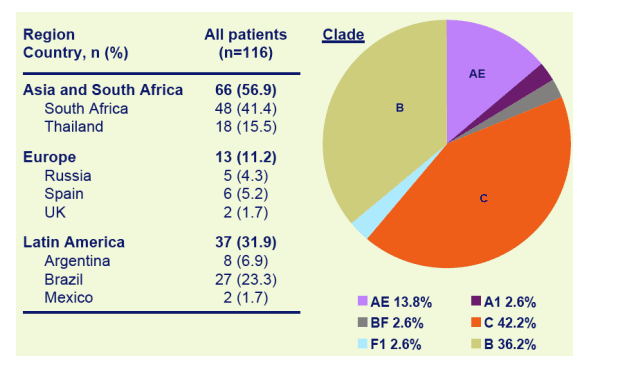
BASELINE RESISTANCE
BASELINE NRTI MUTATIONS
A large number of NRTI resistance-associated mutations were noted in this first line failure population.
Many NRTIs were recycled in this study:
-- In the TMC125 group: 37% recycled one, 9% two;
-- In the Control group: 35% recycled one, 12% two
35% of patients receiving TMC125 had 3 or more NRTI mutations.
You can see in this table that 28.8% in TMC125 group & 38.6% in Control group had 1 NRTI mutation; 15% in TMC125 group & 10% in Control group had 2 NRTI mutations; 10% in the TMC125 group & 7% in the Control group had 3 NRTI mutations; 16.9% in TMC125 group & 10.5% in Control group had 4 NRTI mutations; and 6.8% in TMC125 group & 8.85 in Control group had 5 NRTI mutations.
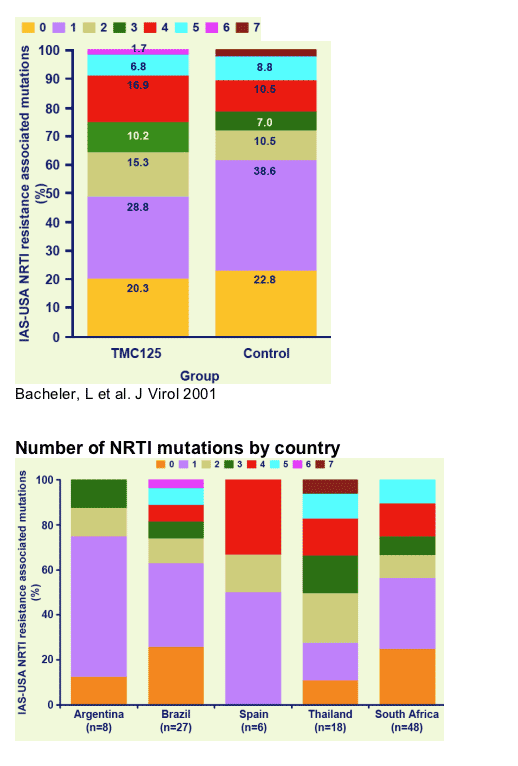
Baseline detectable NNRTI Mutations
23.7% of patients receiving TMC125 had 1 NNRTI mutation; 40.7% had 2 mutations; 23.7% haf 3 NNRTI mutations; 5.1% had 4 NNRTI mutations.
large number of NNRTI mutations** were noted in this first line failure population.
Median fold change to:
Efavirenz 129.8
Nevirapine 88.0
TMC125 2.0
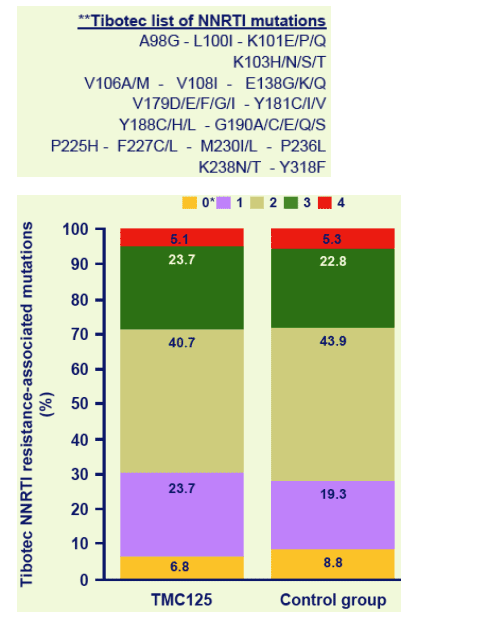
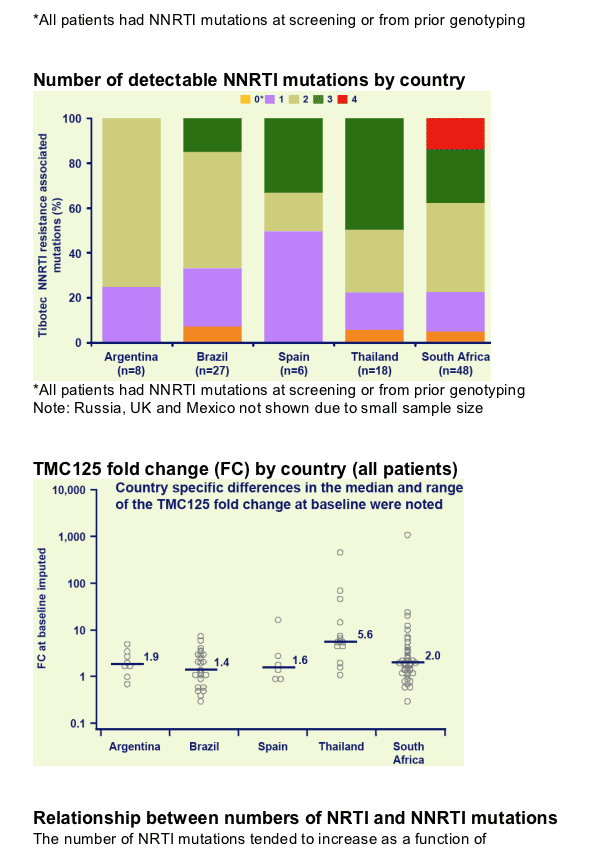
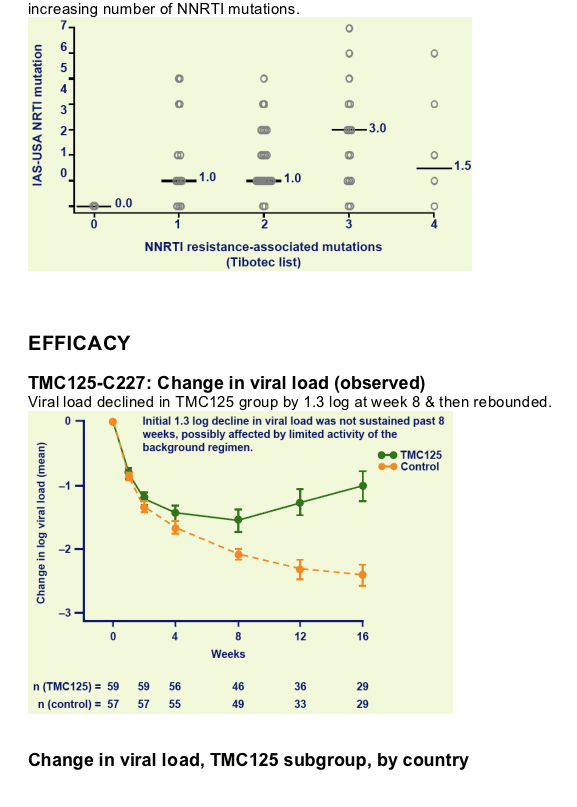
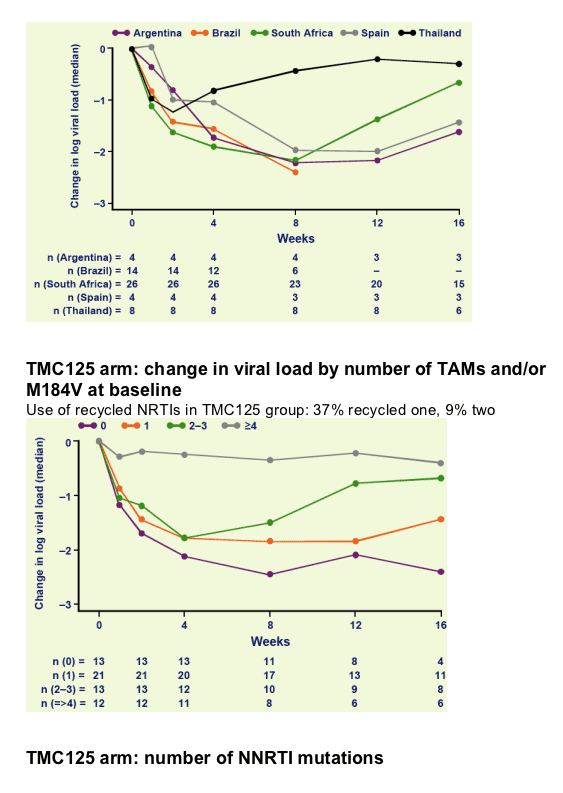

TMC125-C227 Safety Summary
Nervous system and psychiatric disorders were comparable between the groups
-- headache most common nervous AE; 14% in each arm
Rash 10% in TMC125 group
-- No grade 3 or 4 rash
--No gender difference
Gastrointestinal (GI) effects were less with TMC125 than PI therapy
-- diarrhoea3% TMC125 vs 25% PI group
Grade 3 and 4 AEs were comparable between the two groups
--10% TMC125 vs12% PI group
Serious AEs infrequent and comparable between groups
-- 3% TMC125 vs 2% PI group
No consistent or relevant trend for grade 3 or 4 laboratory abnormalities
-- lipid and bilirubin elevations were less frequent with TMC125 than PI therapy
AUTHOR CONCLUSIONS
The level of both NRTI and NNRTI resistance was higher than what might have been expected from a first-line failure population.
-- Many patients recycled previously used NRTIs
Increasing numbers of TAMs and M184V were associated with increased NNRTI resistance.
The combination of high level NRTI and NNRTI resistance adversely impacted the TMC125 arm.
-- Less likely to have affected the PI arm in this PI-naive population
Consistent with treatment guidelines, patients failing a first-generation NNRTI should immediately switch their regimen to avoid the accumulation of multi-class resistance.
|
| |
|
 |
 |
|
|